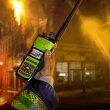A wild ride
The Jesusita Fire swept through the hills of Santa Barbara, Calif., in May, burning more than 8,700 acres of wildland and urban areas. To contain the fire, roughly 259 local, state and federal agencies had to be coordinated under a unified command, said Patrick McElroy, a battalion chief with the city of Santa Barbara Fire Department.
“The difficulty of this fire was organizing everyone, tracking the resources and communicating with everyone on scene,” McElroy said.
The fire impacted the national forest, the wildland-urban interface, and Santa Barbara county and city lands. It’s scope forced the city and county communication centers to immediately move into a unified command. McElroy said the unified command included the city, Santa Barbara County, the U.S. Forest Service and the California Department of Forestry and Fire Protection (CAL FIRE), which protects more than 31 million acres of the state’s privately owned wildlands. Before long, the California Emergency Management Agency (CEMA) became involved to coordinate all local, regional and state resources.
Resources needed to fight the fire came from throughout the state, McElroy said. Equipment was moved on a regional and local basis under the advisement of CEMA.
One of CEMA’s roles is to connect local and regional resources so they can be used state-wide during emergencies, said Kim Zagaris, the agency’s state fire and rescue chief and a 35-year fire service veteran. However, such mutual-aid assistance is starting to become sparse, Zagaris said, as local and regional agencies begin to feel the sting of budget cuts from the current economic crisis.
“It’s a big issue because the availability of mutual aid up and down the state and across the nation depends primarily on local government resources,” he said. “If departments are laying people off or blocking out fire stations — there’s going to be fewer resources.”
California has one of the largest mutual-aid systems in the country, Zagaris said. During FY 2008 and FY 2009, CEMA moved nearly 1,200 strike teams and more than 600 fire engines. The response for this year cost the state about $1 billion, he said.
“That’s for fire, flood response and other incidents,” he said. “But the fire side of the house is the majority of all those costs.”
For the Jesusita Fire, CEMA determined the available resources from surrounding communities and coordinated the movement of such resources into the Santa Barbara area. Resources included apparatus and communication equipment from local departments. While some state and local agencies have rotary helicopters and fixed-wing capability, most of the aircraft generally came from the CAL FIRE and federal wildland agencies.
CEMA organized resources using a tiered response system, Zagaris said. Notifications are issued at the local, county, regional and state levels. At the same time, the agency also works with CAL FIRE to coordinate the movement equipment from the southern to northern border of the state.
Statewide resources are managed through CEMA’s two geographical information coordination centers. The centers are joint interagency facilities. Staff at the facilities includes employees of CEMA, the U.S. Forest Service, the Department of the Interior and CAL FIRE. The GIC centers feed information into a joint dispatch center for fire and rescue staffed by CAL FIRE and CEMA, Zagaris said.
“That’s where the heartbeat of our organization is,” he said of the centers.
Zagaris said the state’s first responders on scene use a VHF communications system, although some personnel are on 800 MHz and 400 MHz systems. Military-grade two-way radios are used to handle the demands of a rugged fire environment. Personal cell phones also are used for command and tactical personnel.
The 800 MHz network is hit or miss, Zagaris noted.
“During the ’03 and ’07 fire season during fires in San Diego we had big problems with the system being filled to capacity,” he said. “To me communications is like freeways in the morning and the evenings: how much load they’ll take is the real question before there is hiccup down the line. And we don’t want to see a hiccup that leads to injury or loss of life, which is unacceptable.”
For remote communications, mobile command trailers are deployed that have satellite communications links and phone lines. If a fire threatens existing mountain-top or urban communications sites, his team also brings in portable repeaters to carry voice communications back to the GIC centers, Zagaris said.
Zagaris emphasized the importance of building regional, instead of strictly local, systems — especially in today’s economy — and that federal agencies need to financially support the effort.
“Find ways at local and state and federal levels to make that cooperation available and continue to tell our federal folks that they need funding from the DHS side of the house to meet these communication goals that they would like to see since 9/11 [for example] interoperability,” he said. “None of us have enough resources to manage every emergency. We have to work together to get those resources and build on those systems. It can’t be a top-down system. We need to continue a bottom-up approach. Remember, firefighters, EMS and police are the ones getting it done. It’s surely not the bureaucrats sitting in those offices with their suits and ties.”
The U.S. Forest Service played a crucial role in the Jesusita Fire, said Ralph Domanski, assistant director for fire operations in Southern California for the agency. One of the roles of the Forest Service is to carefully monitor federal preservation lands for fire dangers, he said, and the agency has systems in place to do just that.
Fighting wildfires is becoming more challenging. Domanski said fires now burn longer and stronger, as California builders continue to develop communities that line national forest boundaries. “The real issue of fires is the amount of people who are moving closer and closer to the national forest boundaries, and those people who are building homes within that wildland-urban interface,” he said.
Having additional population and structures to protect means reliable, interoperable communications become more essential to operations. Eric Martinez is the Southern California area leader and works on the communication systems during fire incidents for the Forest Service. Martinez said that in the Southern California backcountry, communications sites are set up that consist of repeaters, backhaul links and remote base stations. The agency owns towers in the backcountry that support a mountain-top backbone repeater system to carry voice communications from San Diego to the Oregon border.
Martinez said his team operates a narrow-band VHF radio system for command communications and a UHF system for tactical and backhaul communications.
The agency doesn’t depend on satellite for communications — yet.
“Eventually we will because our mountain-top repeater systems are older … and are vulnerable to fires,” Martinez said.
Part of fire operations is to protect such communications infrastructure, both public and private. Domanski said the Forest Service permits commercial communications operators to lease space on the agency’s mountain-top communication sites. Such commercial entities typically lease the property and often install their own towers.
“Our communications … that’s one of those things we try to protect,” he said. “We have tankers drop [fire suppressions] around communications sites whether it’s ours or even private, because we have a lot of private entities on national forest land.”
Weather data helps the agency determine fire dangers. On the forest floor, sensors inside automated stations monitor conditions — such as drought — and feed data into the agency’s weather information management program around the clock.
The Forest Service has digital capabilities but has not deployed the systems yet, because other agencies that respond to an incident under mutual aid often don’t have such capabilities.
“We don’t want to exceed the standards that they have,” Domanski said. “Otherwise, we wouldn’t be able to talk to them.”
Interference always is an issue, Martinez said. But it usually can be eliminated by tone-protecting the equipment.
“We also work closely with our frequency coordinators and they kind of make sure we are clear of any adjacent channels or any kind of interfering channels,” he said.
Martinez said a major challenge is to keep multiple agencies trained on communication systems that sit on the shelf between fire seasons.
“You have a lot of cooperating agencies, and they often haven’t touched them since last fire season and they don’t have their own. They are 800 or 400 MHz trunked systems and it’s really foreign to them,” he said. “So cooperating with federal and other agencies to make sure if they are going to go to these wildland fires that they know how to operate the equipment is really important.”
JESUSITA FIRE STATS
8,733 acres burned
1,857 personnel on scene
111 engines
1 air attack tanker and 4 helicopters
30 firefighter injuries
$17 million cost of response
Source: Santa Barbara County
Related Stories

















